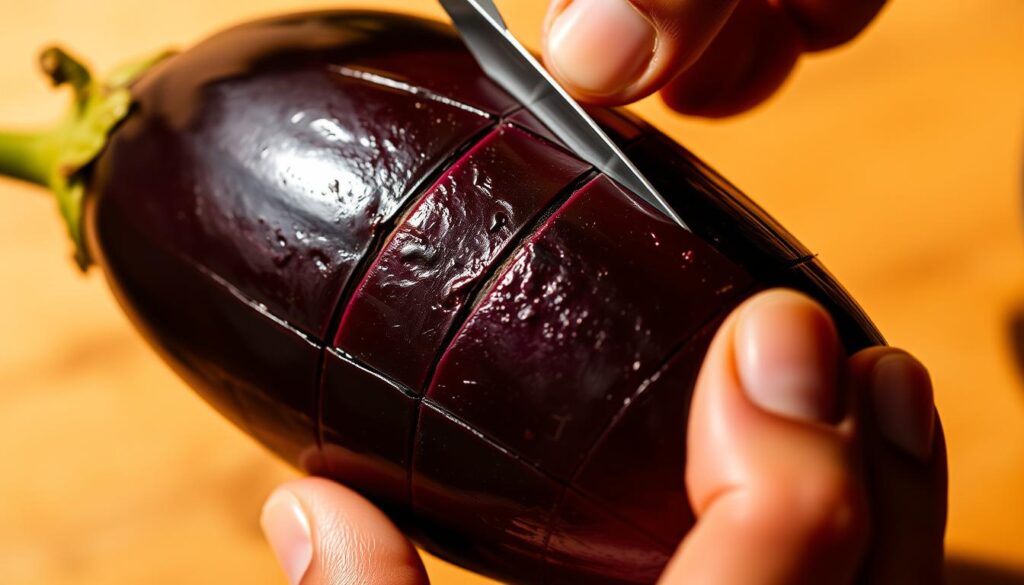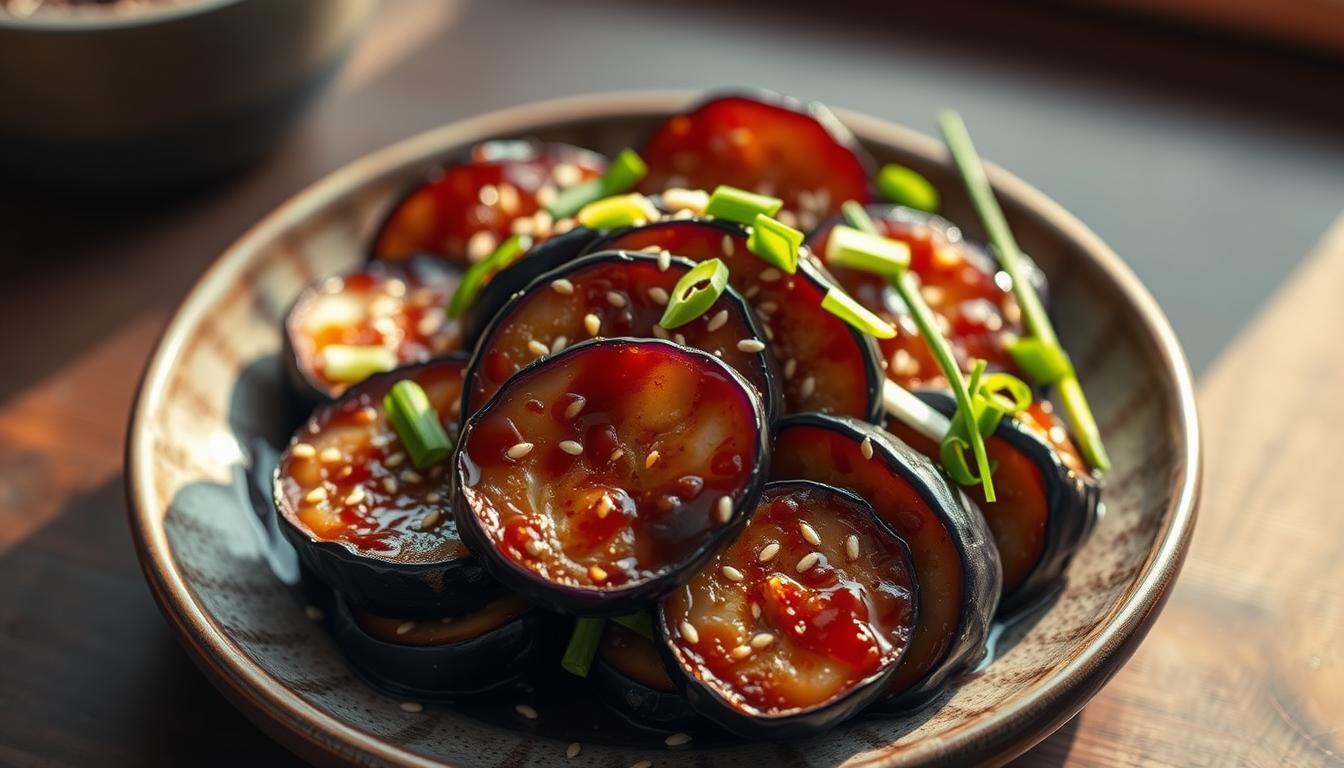Table of Contents
The first time I tasted miso-glazed eggplant, my world changed. It was in a small Tokyo restaurant. There, a simple vegetable turned into an unforgettable taste experience.
Miso-glazed eggplant is more than a recipe. It’s a journey into traditional Japanese cooking. It’s perfect for anyone, whether you’re new to cooking or a seasoned food lover.
The magic of miso glaze is amazing. It turns tender eggplant into a dish that’s sweet, savory, and complex. Every bite is a journey of texture and taste that will make your cooking better.
Key Takeaways
- Discover the rich umami flavor of authentic miso-glazed eggplant
- Learn how simple ingredients create complex taste experiences
- Explore the cultural significance of Japanese cuisine through one dish
- Master a versatile recipe suitable for various skill levels
- Transform humble eggplant into a gourmet culinary creation
Understanding the Magic of Miso-Glazed Eggplant
Explore the world of miso-glazed eggplant, a true culinary treasure. It connects us to Japan’s rich cooking history. This dish is more than a recipe; it’s a story of flavor and health.
The History of Miso Glazing
Miso glaze’s roots go back to ancient Japan. Back then, it was all about keeping food fresh and adding flavor. Farmers and cooks turned simple foods into amazing dishes.
- Origins date back to the Edo period (1603-1867)
- Initially used as a preservation method
- Evolved into a sophisticated cooking technique
Cultural Significance in Japanese Cuisine
In Japan, miso glazing is a deep cooking art. Each area has its own twist, using local ingredients and cooking ways.
Health Benefits Overview
Miso-glazed eggplant is not just tasty; it’s also super healthy. The mix of miso and eggplant is packed with nutrients for better health.
- Rich in antioxidants
- Low-calorie vegetable option
- Supports digestive health
- Provides essential minerals
Learning about miso-glazed eggplant’s history and health benefits shows it’s more than food. It’s a journey through Japanese tradition and taste.
Essential Ingredients for Perfect Miso Glaze
Starting an authentic miso-glazed eggplant means knowing the key ingredients. These ingredients add depth and complexity to your dish. The heart of a great miso glaze is choosing the right miso paste types.
Miso paste has three main types, each with its own flavor:
- White Miso (Shiro): Mild and slightly sweet, great for delicate dishes
- Yellow Miso (Shinshu): Balanced flavor with moderate saltiness
- Red Miso (Aka): Intense and robust, perfect for bold recipes
The secret to a perfect glaze is balancing sake, mirin, and sugar. These ingredients blend together to create a harmonious flavor. This transforms simple eggplant into a culinary masterpiece.
| Ingredient | Flavor Profile | Purpose in Glaze |
|---|---|---|
| Sake | Mild, slightly sweet | Adds depth and helps tenderize |
| Mirin | Sweet rice wine | Provides sweetness and glossy finish |
| Sugar | Pure sweetness | Balances saltiness of miso |
Choose high-quality, authentic ingredients. Japanese grocery stores or specialty markets have the best miso paste types and traditional seasonings. Even if you can’t find exact ingredients, many supermarkets now carry these essentials.
Selecting and Preparing Your Eggplants
Choosing the right eggplant is key for a tasty miso-glazed dish. The eggplant you pick can make or break the recipe. Knowing the differences between varieties is important for success in the kitchen.
Japanese vs. Globe Eggplant Characteristics
There are two main types of eggplants: Japanese and globe. Each has its own special qualities for cooking:
- Japanese eggplant: Slender, elongated shape with thin skin
- Globe eggplant: Larger, rounder, with thicker skin
Ripeness and Storage Insights
Finding a ripe eggplant takes some skill. Here’s how to spot a fresh one:
- Smooth, glossy skin without blemishes
- Firm texture with slight give when gently pressed
- Vibrant, deep purple color (for most varieties)
Pre-Cooking Preparation Techniques
Getting your eggplant ready before cooking can really enhance its taste and texture. Here are some important steps:
- Salting: Helps remove excess moisture and reduces bitterness
- Scoring: Creates channels for better glaze absorption
- Trimming: Remove stem and cut into desired shapes
| Eggplant Type | Best Cooking Method | Flavor Profile |
|---|---|---|
| Japanese Eggplant | Broiling | Delicate, slightly sweet |
| Globe Eggplant | Grilling | Robust, meaty texture |
Pro tip: Always store your eggplants in a cool, dry place. Use them within 2-3 days for the best flavor and texture.
Making the Perfect Miso Glaze
To make a great miso glaze, you need to be precise and know how to balance flavors. Choosing top-notch ingredients and using the right techniques are key. Your miso glaze will turn a simple eggplant dish into a work of art.
Here are the must-have ingredients for your miso glaze:
- White or yellow miso paste – adds deep umami flavor
- Sake or mirin – brings a hint of sweetness
- Granulated sugar – balances out the saltiness
- Rice vinegar – adds complexity
Getting the glaze’s consistency just right is important. Start by mixing miso paste with your liquid ingredients until it’s smooth. Then, heat it slowly, stirring constantly to avoid burning. The perfect glaze should slide off a spoon and look silky and glossy.
To make your miso glaze even better, try adding these:
- Minced fresh ginger
- Crushed garlic
- Sesame oil
- Chili flakes for a spicy kick
Keep tasting and tweaking your glaze. You want a mix of sweet, salty, and umami that brings out the eggplant’s flavor. A well-made miso glaze can take your dish from good to amazing.
Step-by-Step Cooking Technique
Learning to make miso-glazed eggplant is all about precision and technique. It’s a journey that starts with knowing the key steps. These steps turn a simple eggplant into a dish full of umami flavors.

Eggplant Scoring: Preparing the Canvas
Eggplant scoring is key to getting your dish to soak up flavors and cook right. Here’s how to do it right:
- Use a sharp knife to make shallow diamond cuts
- Cut about 1/2 inch deep into the flesh
- Make sure cuts are about 1 inch apart
- Don’t cut all the way through the skin
Broiling vs. Grilling: Choosing Your Cooking Method
There are two main ways to cook miso-glazed eggplant: broiling and grilling. Each method has its own benefits for getting that perfect caramelized outside.
| Broiling Eggplant | Grilling Eggplant |
|---|---|
| Consistent heat distribution | Smoky flavor profile |
| Better for indoor cooking | Ideal for outdoor gatherings |
| Easier temperature control | Direct flame adds char marks |
Timing and Temperature Mastery
Cooking times depend on your method. For broiling, aim for 10-15 minutes at 450°F. Grilling takes 8-12 minutes, turning often for even caramelization.
Pro tip: Brush your eggplant with miso glaze during the last 3-4 minutes of cooking. This prevents burning and adds a rich, golden crust.
Common Mistakes to Avoid When Making Miso-Glazed Eggplant
Mastering miso-glazed eggplant takes practice and knowing common mistakes. Many home cooks face challenges in getting the flavor and texture right.
Here are some key miso glaze mistakes to watch out for:
- Incorrect Salting Technique: Not salting and draining eggplant properly can make it bitter and watery.
- Uneven cutting that prevents uniform cooking.
- Using low-quality or expired miso paste.
- Overlooking essential seasoning adjustments.
Fixing your miso-glazed eggplant starts with knowing common mistakes. The most common errors include:
- Burning the glaze due to high heat.
- Not allowing enough time for flavor absorption.
- Selecting incorrect eggplant varieties.
- Skipping the pre-cooking preparation steps.
Your cooking technique is very important. Watch for signs of over-caramelization and learn to adjust your broiling or grilling method. Pay close attention to the glaze’s consistency and the eggplant’s texture to prevent kitchen disasters.
Remember, practice makes perfect. Each cooking attempt gives you valuable insights into making the ultimate miso-glazed eggplant dish.
Pairing Suggestions and Serving Ideas
Make your miso eggplant dish stand out with creative serving ideas. Mix traditional Japanese side dishes with modern fusion cuisine. This umami-rich dish opens up new culinary adventures, changing how you enjoy meals.
For traditional Japanese sides, look for flavors and textures that match the miso-glazed eggplant’s deep taste.
Classic Japanese Pairings
- Steamed short-grain white rice
- Light miso soup
- Pickled daikon radish
- Edamame beans
- Cucumber sunomono salad
Innovative Fusion Combinations
Try exciting fusion cuisine to turn your miso eggplant into a global dish. These pairings mix Japanese traditions with new cooking styles.
- Quinoa bowl with roasted vegetables
- Mediterranean-inspired grain salad
- Korean-style barbecue platter
- California-inspired vegetarian tacos
Beverage Recommendations
Choose drinks that bring out the miso eggplant’s rich flavors:
- Chilled sake
- Light-bodied Pinot Noir
- Crisp Japanese beer
- Green tea
Try these pairings to make a memorable meal. Celebrate the versatility of miso-glazed eggplant in different cuisines.
Storing and Reheating Tips
Learning how to store leftover eggplant can make your meal prep better. It lets you enjoy miso-glazed eggplant all week. Keeping it fresh is all about the right storage.
Here’s how to store your miso-glazed eggplant:
- Cool the eggplant completely before storing
- Use airtight containers to prevent moisture loss
- Refrigerate within two hours of cooking
- Store in the refrigerator for up to 3-4 days
Reheating miso eggplant needs gentle care to keep it tender. Here are the top ways to do it:
- Oven Method: Preheat to 350°F, place eggplant on a baking sheet, cover with foil, and warm for 10-15 minutes
- Stovetop Technique: Use a non-stick pan on low heat, cover and warm for 5-7 minutes
- Microwave Option: Heat in 30-second intervals, checking to prevent overcooking
Freezing miso-glazed eggplant is also an option. Wrap it in freezer-safe containers or bags. To thaw, let it sit in the fridge overnight. Then, reheat it using the methods above.
Meal prep tip: Cook big batches of miso-glazed eggplant. Portion them out for quick, tasty meals all week. This saves time and keeps your meals flavorful.
Variations and Alternative Recipes
Trying out different ways to make miso-glazed eggplant can really spark your creativity in the kitchen. You might want to change things up for dietary reasons or just to try new tastes. These variations will make your dish stand out.
Vegan Miso Eggplant Innovations
Making a vegan miso eggplant dish is simpler than you might think. Old recipes often use honey or fish sauce, but you can find great substitutes. Here are a few:
- Replace honey with maple syrup or agave nectar
- Use tamari instead of traditional soy sauce
- Swap fish sauce with mushroom-based umami sauce
Spicing Up Your Miso Glaze
A spicy miso glaze can make your eggplant dish amazing. Here’s how to add some heat:
- Add gochujang or sriracha to your base glaze
- Sprinkle red pepper flakes before roasting
- Mix in finely chopped fresh chili peppers
Sweet Miso Eggplant Transformations
If you like a bit of sweetness, try a sweet miso eggplant version. Caramelizing it brings out amazing flavors:
- Add a tablespoon of brown sugar to your glaze
- Drizzle with thick date syrup after cooking
- Garnish with candied ginger for extra sweetness
Each variation gives a fresh spin on the classic dish. It’s a chance to make it your own. Feel free to try new things and find your favorite flavor mix!
Expert Tips for Restaurant-Quality Results
To make your miso-glazed eggplant taste like it’s from a restaurant, you need to learn some pro cooking tricks. Chefs know that making food great is not just about what you put in it. It’s about how you do it.
Here are some tips from the experts to make your miso eggplant look and taste amazing:
- Use high-quality Japanese miso for authentic depth of flavor
- Select eggplants with smooth, unblemished skin for optimal texture
- Salt eggplants to remove excess moisture before cooking
- Invest in a reliable broiler or grill for consistent heat distribution
Professional kitchens focus on using the best ingredients and cooking with precision. When making miso-glazed eggplant, pay attention to how you cut and cook it. A sharp knife and even scoring help with glazing and presentation.
Getting the umami flavor right is all about knowing how ingredients work together. Try adding things like toasted sesame oil, green onions, or bonito flakes. They can make your dish taste like it’s from a fancy restaurant.
- Brush glaze multiple times during cooking for layered flavor
- Use ceramic or cast-iron dishes for even heat absorption
- Let eggplant rest briefly after cooking to absorb final flavors
With a bit of practice and focus on the details, you can make your miso-glazed eggplant a hit. It will impress anyone who tries it.
Conclusion
Learning to make miso eggplant opens the door to real Japanese cooking. It shows how simple ingredients can become amazing dishes. You’ve discovered how to make eggplant a special treat for your taste buds.
Making miso-glazed eggplant is more than just following a recipe. It’s about joining a tradition that values precision and rich flavors. Now, you can make dishes that taste like they’re from a restaurant, right in your own kitchen.
Keep practicing and loving what you do. Every time you make miso-glazed eggplant, you get better. You’ll learn more about umami flavors and connect with a cooking tradition that’s been around for ages. Your kitchen is where you create your own masterpiece.
Don’t be afraid to try new things and follow your gut. Enjoy the adventure of finding new tastes. Your hard work and curiosity will make your cooking better and open up new flavors for you to explore.

